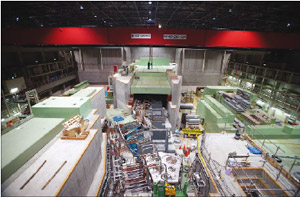The Main Ring at the Japan Proton Accelerator Research Complex (J-PARC) has reached a new milestone with the successful extraction of a proton beam to the Hadron Experimental Hall and then to the beam dump.

Image credit: KEK.
J-PARC, a joint project of the Japan Atomic Energy Agency and the KEK laboratory, has been under construction at Tokai since 2001. With a 1600 m circumference and a 500 m diameter, the 50 GeV synchrotron of the Main Ring is the third and final stage in the accelerator complex. The first stage is the linac, followed by the 3 GeV synchrotron. The Main Ring will operate at 30 GeV in the first phase of the project.
The proton-beam tests at J-PARC started in November 2006 and had reached the initial goal for protons in the Main Ring of 30 GeV by December 2008. Then on 27 January, 30 GeV protons were extracted from the Main Ring to the secondary particle-production target, T1, located 250 m downstream in the Hadron Experimental Hall and were transported onwards to the beam dump.
The Hadron Experimental Hall, which is one of two facilities at the Main Ring, will provide beams of secondary particles produced by the protons. These beams will be the most intense secondary-particle beams at this energy and should facilitate several different experiments, including precise measurements of CP violation in K mesons and studies of the collective motions of strange quarks in hypernuclei. To make an abundance of secondary particles available from the primary proton beam has required the development of various methods for handling the high-intensity primary beam. This has required the construction of a dense radiation shield and magnets for the high-radiation area that are rugged enough and easily replaceable if problems arise.
Neutron and muon beams are already available in the Material and Life Science Facility at J-PARC. With the success of the Hadron Experimental Hall, an important goal is to send high-power neutrino beams to the Super-Kamiokande neutrino detector, 295 km away.





